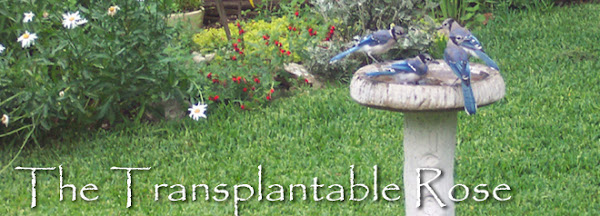Breaking news from Chicagoland: Do you remember seeing a peach tree in full bloom at my sister's house? It sprouted 4 years ago when my my nephew Jake and his parents planted a Harry & David peach pit. Jake is proud to announce there are real peaches hanging from those branches!

Memorial Day weekend is sometimes called the Gateway to Summer, but we in Austin passed through that gate quite a while ago. Yesterday was another hot day, reaching 99 degrees Fahrenheit in the afternoon, the kind of day where the birds hide and only the bugs look busy and you hope for any little movement of the air. Then with a whoosh, the wind swept in yesterday evening, tossing the trees and plunging us into the low seventies overnight, rebounding to the nineties by lunchtime.
 I was sure the 'Cupani' Sweet peas would fade once the heat hit, practically writing their obituary in the May 15th Bloom Day post, but they fooled me - still hanging their rose and blue-violet flowers on the obelisk near the 'Black Knight' butterfly bush, the Tropical orange & yellow milkweed, Salvia farinacea and yellow lantana.
I was sure the 'Cupani' Sweet peas would fade once the heat hit, practically writing their obituary in the May 15th Bloom Day post, but they fooled me - still hanging their rose and blue-violet flowers on the obelisk near the 'Black Knight' butterfly bush, the Tropical orange & yellow milkweed, Salvia farinacea and yellow lantana. The Pink Entrance Garden never had its photo taken for Bloom Day - there doesn't seem to be any time of day when photos taken there are free of shadows or glare or there isn't something ugly intruding on the view. This one taken looking NW toward the street isn't too bad, once I carefully cropped the trash cans from the photo!
The Pink Entrance Garden never had its photo taken for Bloom Day - there doesn't seem to be any time of day when photos taken there are free of shadows or glare or there isn't something ugly intruding on the view. This one taken looking NW toward the street isn't too bad, once I carefully cropped the trash cans from the photo!
Facing back in the direction of the garden gate you can see that one plant of 'Purple Stars' Coneflowers have finally opened, rioting with pink gaura, heirloom petunias, some lingering larkspur, the first balloon flowers and at lower right, a fully loaded pink chrysanthemum. This spring bloom cycle of chrysanthemums seems normal to me now, but I was surprised back in 2000 to find that a plant that was a sure sign of fall in the north was both a spring and fall plant in Texas.

The 'Little Gem' magnolia is never covered in flowers, but it opens them one or two at a time, off and on once May arrives, enough so there is a light fragrance whenever I'm within 10 feet of the small tree. I caught this flower after it opened, but before pollination led to the stamens browning and dropping into the cup of the flower.

In the previous post I talked about Austin Passalong Plants - but what can we call those toted-from-one garden to another plants that we originally bought from a nursery? I think they must be Pack-Along Plants. The daylily below is 'Prairie Blue Eyes', one of the daylilies that I brought from my Illinois garden in 1999. It barely survived life on the deck at the other Austin house, dwindling down to one leaf by the time we moved to this house in July 2004. After we made the Hummingbird garden that winter I planted the tiny thing, and was pleased to see it thrive.... it has five budded stalks this year!
 But no matter how beautiful the flowers are, the thing that looks and smells like summer for many of us are tomatoes. We have enough room to make a 10X10-foot tomato patch at this house, but could have used a few of VDBD's Grow-Boxes at our previous house so we could have grown tomatoes on the deck instead of keeping them enclosed in a wire structure. Meems has been taunting us for weeks with the tomatoes she's harvesting from her Florida garden! Vertie in Hyde Park had lots of green tomatoes last, but was a little too busy being part of a Central Texas Gardener taping to give us the current status.
But no matter how beautiful the flowers are, the thing that looks and smells like summer for many of us are tomatoes. We have enough room to make a 10X10-foot tomato patch at this house, but could have used a few of VDBD's Grow-Boxes at our previous house so we could have grown tomatoes on the deck instead of keeping them enclosed in a wire structure. Meems has been taunting us for weeks with the tomatoes she's harvesting from her Florida garden! Vertie in Hyde Park had lots of green tomatoes last, but was a little too busy being part of a Central Texas Gardener taping to give us the current status.A few days ago Bonnie at Kiss of Sun showed us her vegetable garden and mentioned that the 'Brandywine' tomato wasn't doing much. We planted one of these potato-leaved heirlooms, too - and it's finally starting to make flowers.
 That's the only variety without at least a few green fruits-in-progress. Philo made a new structure for the tomatoes this year, an interlocking wooden grid with the plants lightly looped up just enough to keep them off the ground. In the North many tomato growers prune excess leafage and tie the plants to stakes so they get more sun. Down here I've seen advice to use foliar feed and adequate water in order to produce lots of leaves, in order to give protection from excess sun to the developing fruit. That's what we're trying this year.
That's the only variety without at least a few green fruits-in-progress. Philo made a new structure for the tomatoes this year, an interlocking wooden grid with the plants lightly looped up just enough to keep them off the ground. In the North many tomato growers prune excess leafage and tie the plants to stakes so they get more sun. Down here I've seen advice to use foliar feed and adequate water in order to produce lots of leaves, in order to give protection from excess sun to the developing fruit. That's what we're trying this year.
Last year's flooding was not good for tomatoes, and we still wonder whether traces of Juglone from too many pecan leaves in the garden had a negative effect. Since last fall we've added lots of cotton bur compost and also used products like John Dromgoole's Terra-Tonic for soil. It's hard to know whether what happens in a vegetable garden is actually a result of anything we've done or if it's a response to things beyond our control, like weather, but the plants do look better than in either 2006 or 2007.
 Leave the fruit on the plant one minute past the pale orange stage and you can kiss it goodbye- some bird or critter will get it. The tomatoes take just a few days inside to be ready to eat. We've already eaten a dozen of the small, grape-shaped 'Juliet' tomatoes and those slightly larger 'Viva Italia' plums will soon be red. Large slicing tomatoes for sandwiches may still be a dream, but Pico de Gallo can be a reality!
Leave the fruit on the plant one minute past the pale orange stage and you can kiss it goodbye- some bird or critter will get it. The tomatoes take just a few days inside to be ready to eat. We've already eaten a dozen of the small, grape-shaped 'Juliet' tomatoes and those slightly larger 'Viva Italia' plums will soon be red. Large slicing tomatoes for sandwiches may still be a dream, but Pico de Gallo can be a reality!This post "Flowers, Fruit and Pack-Along Plants" was written by Annie in Austin for the Transplantable Rose.








 A year ago I sang farewell to an
A year ago I sang farewell to an  Our present garden doesn't seem to need deer-resistant plants so our Salvias don't have to work for us - they can just be beautiful.
Our present garden doesn't seem to need deer-resistant plants so our Salvias don't have to work for us - they can just be beautiful.



 Autumn wears a purple hat with her red dress in the photo above. 'Bat-faced' Cuphea llaevea has produced red/purple flowers since early summer.
Autumn wears a purple hat with her red dress in the photo above. 'Bat-faced' Cuphea llaevea has produced red/purple flowers since early summer. 















 The most exciting September openers were a gift from
The most exciting September openers were a gift from 



 Oh - here's another new blossom. My friend Ellen, giver of
Oh - here's another new blossom. My friend Ellen, giver of  Okay, May Dreams Carol! Here's the final flower for
Okay, May Dreams Carol! Here's the final flower for 


 These Balloonflowers - probably Platycodon grandiflora - were brought along as seedlings from Illinois; planted in fall of 2004, they're now looking settled in their second Texas home.
These Balloonflowers - probably Platycodon grandiflora - were brought along as seedlings from Illinois; planted in fall of 2004, they're now looking settled in their second Texas home. 





 Perovskia - called 'Russian sage' with a true sage in the background, Salvia guaranitica.
Perovskia - called 'Russian sage' with a true sage in the background, Salvia guaranitica. Three cupheas are in bloom now.
Three cupheas are in bloom now. 
 The red and purple flowers of Cuphea llavea, nicknamed Batfaced cuphea, aren't very big, but hummingbirds always find them.
The red and purple flowers of Cuphea llavea, nicknamed Batfaced cuphea, aren't very big, but hummingbirds always find them.